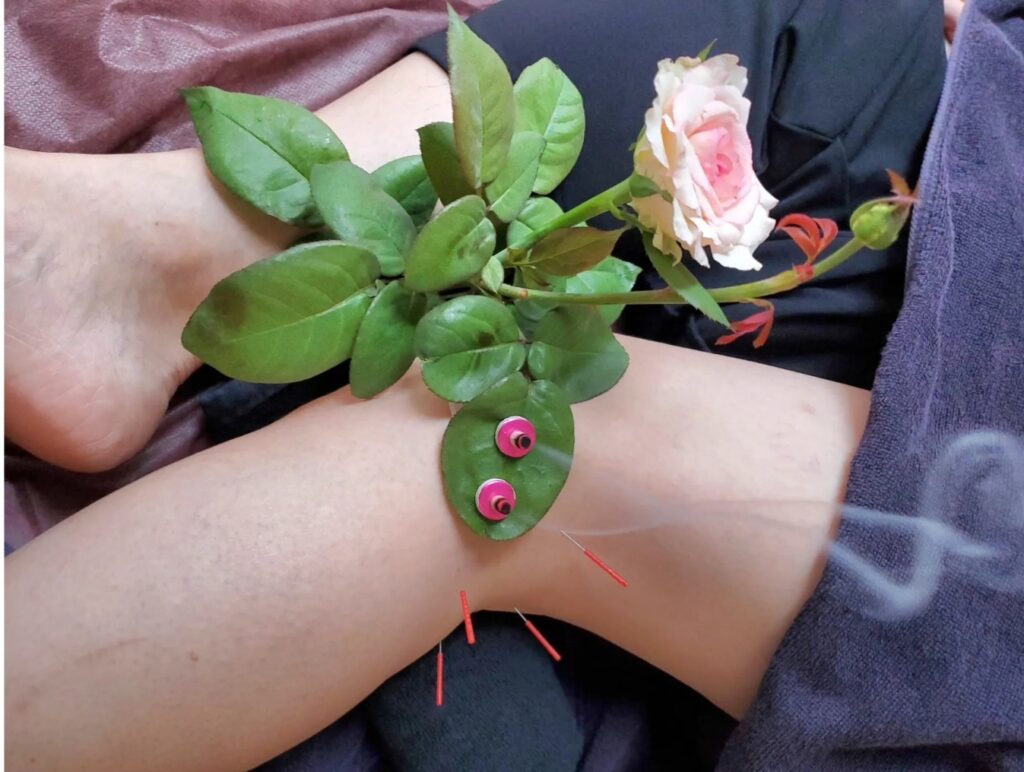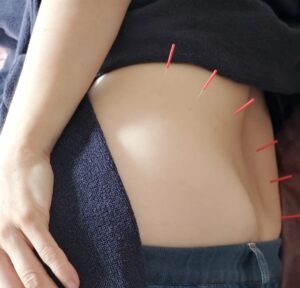膝裏が痛い
Pain behind the knee
膝裏に痛みがでて来院。仕事が立ちっぱなしの業務で、重い物を持ち上げる機会も多く、頻回の膝の曲げ伸ばしをしている。膝に負担をかけてしまっていると自覚。jこのように、膝を酷使すると、膝の関節の軟骨が摩擦などですり減り、次第にひざに強い痛みが出ることがあります。最初は歩き始めに痛みが出ても、休息すれば痛みが治まる程度で済みますが、年齢を重ねるごとに病状が進み、ひどくなると安静にしていても痛みでて歩くことも困難になることもあります。原因としては、加齢のほかに、肥満、O脚、女性なら更年期からの閉経後のホルモンバランスの変化なども膝痛の原因となります。また、患者さん自体の軟骨がもろく傷みやすいといった遺伝的因子も関係してきます。膝の関節には常に体重の4~6倍の負荷がかかるため、肥満も原因となります。初期は階段の上り下り、歩き始め、いつもより長く歩いたとき、イスから立ち上がるときなどに痛みを感じるが、休んでいれば痛み緩和されることが多いです。中期に入ると歩くとたびに痛みを感じたり、ひざがこわばったり、ひざを曲げたり伸ばしたりといった動作がつらくなります。また、ひざに水(関節液)がたまる・腫れる・熱を持つといった症状も現れ始めめす。さらに症状が進むと、関節の軟骨がなくなって骨が直接こすれるため、立ったり歩いたりする動作も難しくなり、ひざの変形も進行することが多くなります。鍼灸治療としては、患部の血行を促進して、血流を促し疼痛緩和をします。痛いからと体を動かさないでいると筋肉が落ちて、さらに症状が進行するため、鍼灸で痛みを軽減させて、運動療法(膝を伸ばすなどの軽い運動から始める)、温熱療法(入浴や灸治療など)なども有効です。患者さんご自身で出来る予防法としては、正しい歩き方を習慣づけます。背筋を伸ばし、歩幅を大きく取るようにして、ひざが自然と伸びるように、かかとから着地する歩き方をするように心がけるなどがあります。また、大臀筋、内転筋、太ももの前の筋肉である大腿四頭筋など、膝周囲に付着する筋肉を簡単なストレッチで鍛えることも有効です。まずは日常生活でなるべく膝に負担をかけないようにしましょう。日常的に立ち仕事や、スポーツを楽しみたいなど、膝の頻回の曲げ伸ばしが避けられない場合には、適度に休憩を挟む、スポーツ前はよく準備運動をするなどしましょう。
She came to the clinic because of pain in the back of her knee. His job requires him to be on his feet a lot, and he often has to lift heavy objects and bend and stretch his knees frequently. She is aware that she puts a lot of strain on her knees.jIf she overuses her knees in this way, the cartilage in her knee joints wears down due to friction and other factors, and she may gradually develop severe pain in her knees. Initially, the pain may begin at the beginning of a walk and subside with rest, but as the patient ages, the condition progresses, and in severe cases, the pain may become so severe that walking becomes difficult even with rest. In addition to aging, other causes of knee pain include obesity, O-legs, and hormonal imbalance after menopause in women. Genetic factors such as the patient's own cartilage being fragile and easily damaged can also play a role. Obesity can also be a cause, since the knee joint is constantly subjected to a load four to six times its body weight. In the early stages of the disease, pain is felt when climbing stairs, starting to walk, walking longer than usual, or getting up from a chair, but the pain is often relieved with rest. In the middle stage, pain is felt whenever walking, the knee becomes stiff, and bending and stretching the knee becomes difficult. In addition, symptoms such as accumulation of water (joint fluid) in the knee, swelling, and heat may also begin to appear. As the condition progresses, the cartilage in the joints disappears and the bones rub directly against each other, making it difficult to stand or walk, and knee deformity often progresses. Acupuncture and moxibustion treatment promotes blood circulation in the affected area to stimulate blood flow and relieve pain. If the patient does not move because of the pain, the muscles will lose strength and the symptoms will progress further, so acupuncture and moxibustion are effective in reducing the pain, and exercise therapy (starting with light exercise such as knee extension) and heat therapy (such as bathing and moxibustion therapy) are also effective. One preventive measure that patients can take on their own is to make it a habit to walk in a correct manner. They should walk with a straight back, take a wide stride, and try to walk with their knees naturally extended and landing on their heels. It is also helpful to strengthen the muscles attached to the knee area, such as the gluteal muscles, adductor muscles, and quadriceps, the muscle in front of the thigh, with simple stretching exercises. First, try to put as little stress on your knees as possible in your daily life. If frequent bending and stretching of the knee is unavoidable, such as when standing or playing sports on a daily basis, take moderate breaks and do preparation exercises before sports.



